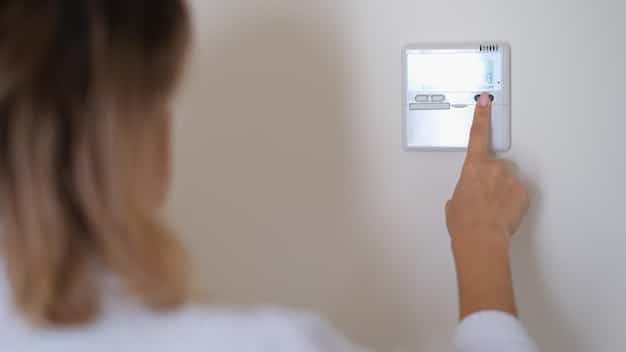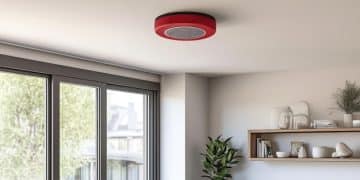Smart Home Accessibility: Adapting for Disabilities in the US

Anúncios
Empowering individuals with disabilities to live more independently, smart home accessibility: adapting your home for people with disabilities integrates innovative technology to create inclusive and supportive living environments, enhancing safety, comfort, and control for diverse needs.
In an increasingly connected world, the potential of technology to foster independence and improve quality of life is immense. For individuals with disabilities, the concept of a smart home accessibility: adapting your home for people with disabilities is not just a convenience, but a profound enabler. It offers practical solutions that redefine daily living, making environments more responsive, intuitive, and, critically, more accessible. This integration of smart technology transforms a house into a personalized hub of support, allowing individuals to navigate their spaces with greater ease and autonomy.
The foundational principles of accessible smart homes
At its core, accessible smart home design is about creating environments that seamlessly adapt to individual needs, rather than requiring the individual to adapt to their environment. This begins with understanding universal design principles, which advocate for products and environments that are usable by all people, to the greatest extent possible, without the need for adaptation or specialized design. Applied to smart homes, this means technology should be intuitive, highly customizable, and compatible with a wide range of assistive devices and user interfaces.
The philosophy extends beyond mere compliance with accessibility standards; it embraces a proactive approach to inclusion. Considerations include not just physical accessibility, but also cognitive, sensory, and communication barriers. This holistic view ensures that smart home solutions truly empower, offering a dignifying and efficient way to manage daily tasks.
understanding universal design in smart homes
Universal design seeks to simplify life for everyone by making products, communications, and the built environment more usable by as many people as possible at little or no extra cost. Its application in smart homes means that features like voice control, customizable interfaces, and intelligent automation are not add-ons but fundamental components from the outset.
- Equitable use: The design is useful and marketable to people with diverse abilities.
- Flexibility in use: The design accommodates a wide range of individual preferences and abilities.
- Simple and intuitive use: Use of the design is easy to understand, regardless of the user’s experience, knowledge, language skills, or current concentration level.
- Perceptible information: The design communicates necessary information effectively to the user, regardless of ambient conditions or the user’s sensory abilities.
These principles guide the selection and implementation of smart devices, ensuring they are not only technologically advanced but also genuinely supportive and inclusive for every resident. This foresight in design minimizes the need for retrofitting and maximizes long-term usability.
integrating diverse user interfaces
A truly accessible smart home offers multiple ways for users to interact with its systems. While voice control has become popular, it’s not universally suitable. Alternative input methods are crucial for those with speech impediments, hearing impairments, or motor disabilities.
Beyond voice, options include large-button physical remotes, touch screens with adjustable sensitivity and visual cues, haptic feedback devices, and even brain-computer interfaces (BCIs) in advanced applications. The goal is to provide choice, allowing individuals to choose the interface that best suits their unique capabilities and preferences, ensuring seamless control over their environment.
This multi-modal approach enhances the overall user experience, making smart home technology a tool for liberation rather than an additional challenge. The flexibility in interaction is a cornerstone of true accessibility, fostering a sense of independence and dignity.
The strategic implementation of these foundational principles guarantees that a smart home is more than just a collection of gadgets; it becomes a thoughtfully designed ecosystem that prioritizes the comfort, safety, and autonomy of all its occupants. This approach is essential for realizing the full potential of home automation in improving lives.
Enhancing daily living through smart automation
Smart automation in an accessible home goes far beyond simple convenience; it provides vital support structures that can significantly improve daily quality of life for individuals with disabilities. By automating routine tasks, smart technology reduces physical effort, mitigates safety risks, and provides a greater sense of independence. This section explores how various smart devices contribute to a more accessible and supportive living environment, making everyday activities simpler and safer.

smart lighting and climate control for comfort and safety
Smart lighting systems offer immense benefits for accessibility. Gone are the days of fumbling for light switches or struggling to reach them. Voice-activated commands, app control, or integration with motion sensors allow lights to be turned on or off, dimmed, or even change color automatically. This is particularly useful for individuals with mobility impairments, visual impairments, or fine motor skill challenges. Automatic lighting can also reduce the risk of falls in low-light conditions, enhancing overall safety.
Similarly, smart thermostats provide effortless climate control. Adjusting room temperature, setting schedules, or pre-cooling/heating can all be done remotely or via voice command. This not only adds to comfort but also helps regulate body temperature for individuals who might have difficulty doing so autonomously, or those with certain medical conditions that require precise environmental control. Integration with occupancy sensors can further optimize energy use and ensure comfort upon entry.
These systems contribute significantly to a home that is responsive to its occupants’ immediate needs, promoting both comfort and vital safety measures. The ability to control these aspects without physical intervention is a cornerstone of an accessible smart home.
automated doors, locks, and window treatments for seamless access
For individuals relying on wheelchairs or with limited upper body strength, traditional doors and locks can be significant barriers. Smart solutions eliminate these obstacles. Automated door openers can be activated via remote control, voice command, or even proximity sensors, allowing for frictionless movement throughout the home. Smart locks, controllable via smartphone, voice, or keypad, remove the need for physical keys, enhancing both convenience and security.
- Entry and exit: Automated front doors and garage doors provide easy, hands-free access.
- Internal movement: Interior doors can be motorized to open and close smoothly, facilitating room-to-room transitions.
- Security and convenience: Smart locks offer remote access for caregivers or emergency services, and easy entry for residents.
Automated window treatments, such as smart blinds or curtains, offer similar benefits. They can be programmed to open and close at set times, or controlled manually via voice or app. This allows for precise control over natural light and privacy without physical exertion, benefiting individuals with limited reach or dexterity. The cumulative effect of these automated features is a living space that feels more fluid and less encumbered by traditional physical limitations.
smart sensors and monitoring for enhanced safety and peace of mind
Beyond convenience, smart sensors play a critical role in safety and well-being. Motion sensors can detect falls and alert caregivers or emergency services. Water leak detectors can prevent significant damage and potential hazards. Smart smoke and carbon monoxide detectors not only alert audibly but can also send notifications to connected devices, ensuring alerts are received even by those with hearing impairments, or when the resident is away from home.
Monitoring systems, including smart cameras, can provide reassurance for family members or caregivers, allowing them to check in on a loved one’s well-being discreetly. These systems often include two-way audio, enabling communication. However, it is paramount that privacy considerations are at the forefront of any monitoring implementation, focusing on dignity and consent.
The integration of these diverse smart automation features transforms a home into a responsive, intuitive, and highly supportive environment. Each technological advancement works in concert to provide a greater degree of comfort, safety, and independence, allowing individuals with disabilities to focus on living vibrantly rather than navigating unnecessary obstacles.
Communication and entertainment: connecting lives
In the pursuit of creating an accessible smart home, the benefits extend significantly beyond mere physical adaptations. The integration of smart technology profoundly transforms how individuals with disabilities communicate with the outside world and engage with entertainment. These advancements foster social connection, reduce feelings of isolation, and offer enhanced opportunities for recreation and learning, thereby enriching overall quality of life.
voice assistants: bridges to control and conversation
Voice-activated assistants like Amazon Alexa, Google Assistant, and Apple Siri have emerged as pivotal tools in smart home accessibility. They enable users to control a vast array of smart devices and access information using natural language, an invaluable feature for individuals with limited mobility or dexterity. For someone unable to physically interact with switches or screens, simply speaking a command can turn on lights, adjust the thermostat, or even unlock a door.
Beyond device control, these assistants act as powerful communication aids. They can initiate phone calls, send text messages, or even connect to video conferencing platforms, allowing seamless interaction with family, friends, and caregivers. This ability to maintain social connections independently is vital for mental well-being and reducing feelings of isolation. Furthermore, voice assistants can read out news, weather updates, audiobooks, and emails, offering a hands-free way to stay informed and entertained.
- Device control: Lights, thermostats, door locks, and more operated by voice commands.
- Communication: Hands-free calls, messages, and video conferences.
- Information access: News, weather, reminders, and general inquiries via voice.
The ongoing development of these technologies includes improved understanding of diverse accents and speech patterns, making them increasingly reliable for a wider range of users. Their transformative power lies in their ability to provide an intuitive and efficient interface that bypasses physical limitations, truly bridging the gap between individuals and their environment.
accessible entertainment systems for enriched experiences
Access to entertainment is a fundamental aspect of human experience, contributing to recreation, learning, and emotional well-being. Smart home technology makes entertainment more accessible than ever before for individuals with disabilities. Smart TVs, integrated with voice assistants, allow users to effortlessly browse channels, select streaming content, or adjust volume without needing to manipulate a remote control.
Beyond television, smart speakers and sound systems provide access to music, podcasts, and audiobooks with simple voice commands, transforming any room into a personalized auditory experience. For those with visual impairments, screen readers integrated into smart devices can describe on-screen content, making navigation of apps and menus possible. Tactile interfaces and customizable display settings are also becoming more common, catering to diverse sensory needs.
The ability to independently control entertainment choices enhances personal autonomy and creates opportunities for engaging with hobbies and interests that might otherwise be challenging. Whether it’s selecting a movie, listening to a favorite album, or exploring a new podcast, smart home technology empowers individuals to curate their leisure time without barriers.
By empowering users through intuitive communication tools and accessible entertainment solutions, smart home technology extends its impact far beyond basic automation. It becomes a catalyst for greater social engagement, personal fulfillment, and an enriched daily life, demonstrating its profound potential in creating truly inclusive living spaces.
Navigating the smart home landscape: device selection and integration
The vast and rapidly evolving landscape of smart home technology can be both exciting and overwhelming. For those aiming to create an accessible living environment, careful consideration of device selection and seamless integration is paramount. It’s not just about acquiring the latest gadgets, but about choosing components that truly meet specific needs and work harmoniously together. This section delves into the practical aspects of building an effective and supportive smart home system, focusing on compatibility, reliability, and finding the right fit for individual requirements.
choosing compatible and reliable devices
Compatibility is the cornerstone of a functional smart home ecosystem. Devices from different manufacturers often operate on varying communication protocols (like Wi-Fi, Bluetooth, Zigbee, Z-Wave). While many modern smart home hubs can bridge these protocols, it’s advisable to prioritize devices that are known to integrate well, preferably within the same ecosystem (e.g., Google Home, Apple HomeKit, Amazon Alexa) or those that support open standards.
- Protocol awareness: Understand if devices use Wi-Fi, Bluetooth, Zigbee, Z-Wave, etc.
- Ecosystem alignment: Consider sticking to familiar platforms for easier management.
- Brand reputation: Research brands known for reliability, customer support, and regular software updates.
- Security features: Prioritize devices with robust encryption and privacy policies.
Reliability is equally critical. For individuals relying on these systems for daily living, a flaky connection or frequent glitches can be more than an inconvenience; they can impact safety and independence. Reading reviews, checking for certifications, and opting for established brands can help ensure the chosen devices perform consistently. Additionally, consider the ease of setup and ongoing maintenance.
Starting with essential functions and gradually expanding the system allows for better understanding of individual needs and device performance before a full-scale investment. This methodical approach minimizes frustration and ensures a more effective accessible smart home.
the role of smart home hubs and platforms
A smart home hub acts as the central brain of your connected home, allowing disparate devices to communicate with each other and be controlled from a single interface. While some smart devices can operate independently, a hub significantly enhances functionality, automation, and ease of management, especially in an accessible home where simplicity is key.
Platforms like Amazon Alexa, Google Home, and Apple HomeKit offer not only voice assistant capabilities but also serve as overarching control centers. They allow users to create routines, set schedules, and manage all connected devices through a single app or voice commands. For example, a “good morning” routine could automatically open blinds, turn on kitchen lights, and start the coffee maker.
When selecting a hub, evaluate its compatibility with your chosen devices, its processing power for complex automations, and its user interface. Some hubs offer advanced customization options for specific disabilities, such as tailored auditory feedback or simplified visual layouts. The right hub can transform a collection of smart gadgets into a seamlessly integrated and highly responsive accessible environment, simplifying daily management and enhancing overall autonomy for the resident.
Thorough planning and research are essential when embarking on smart home integration for accessibility. By prioritizing compatibility, reliability, and a robust central control system, homeowners can build a truly supportive and empowering environment that enhances independence and quality of life for individuals with disabilities.
Overcoming challenges and looking to the future
While the benefits of smart home technology for accessibility are undeniable, the journey to an optimally adapted home is not without its challenges. Addressing these hurdles, from initial setup to ongoing support, is crucial for widespread adoption and effective implementation. As technology continues its rapid advancement, the future promises even greater possibilities, paving the way for more intuitive, integrated, and personalized accessible living solutions.
addressing connectivity and security concerns
A fundamental challenge in smart home accessibility is ensuring reliable connectivity. Many smart devices rely on Wi-Fi, and a weak or intermittent signal can render them ineffective, directly impacting the independence and safety of the resident. Investing in a robust home network, including Wi-Fi extenders or a mesh system, is a critical first step. Regular maintenance of the network and devices is also important to prevent disruptions.
Security is another paramount concern. Smart homes collect and transmit sensitive data, making them potential targets for cyber threats. Homeowners must prioritize devices with strong encryption, regular security updates, and multi-factor authentication. Disabling features not in use, creating strong, unique passwords, and segmenting smart devices on a separate network can further enhance security. Educating users and caregivers about safe digital practices is also essential to maintaining privacy and preventing unauthorized access.
These proactive measures ensure that the benefits of smart accessibility are not undermined by vulnerabilities, providing peace of mind alongside enhanced independence. A secure and stable digital foundation is as important as the physical adaptations in a smart accessible home.
the evolving landscape of assistive technology integration
The pace of technological innovation offers exciting prospects for the future of smart home accessibility. We are already seeing advancements in artificial intelligence (AI) and machine learning (ML) that allow smart homes to learn user preferences and anticipate needs, making automation more proactive and less reliant on explicit commands. Imagine a home that can detect changes in movement patterns and automatically adjust lighting to prevent falls, or one that recommends activities based on observed routines and mood.
The integration of advanced assistive technologies, such as brain-computer interfaces (BCIs) and sophisticated robotics, promises to revolutionize control for individuals with severe motor impairments. BCIs could allow direct control of smart devices through thought, while robotic assistants might help with physical tasks like retrieving items or preparing simple meals. These future developments aim to create environments that are not just responsive, but truly anticipatory and profoundly supportive.
- AI and ML: Predictive automation and personalized environmental adjustments.
- BCI integration: Direct control of devices through neural signals.
- Robotics: Physical assistance with daily tasks, enhancing physical independence.
Furthermore, increased standardization and interoperability between different smart home platforms will simplify setup and expand compatibility, making these technologies more accessible to a wider population. As regulatory frameworks catch up with technological advancements, there will likely be greater support for accessible smart home design, making these innovations more affordable and widely available.
While challenges remain in connectivity, security, and the sheer complexity of options, continuous innovation promises a future where smart homes are not just about convenience, but are integral to fostering unprecedented independence and transforming the lives of people with disabilities. A focus on user-centric design and interdisciplinary collaboration will be key to unlocking this potential.
Funding and resources for accessible smart homes
The vision of a fully accessible smart home, while transformative, can often seem daunting due to perceived costs and complexity. However, numerous funding avenues, government programs, and supportive organizations exist to help individuals and families navigate this journey. Understanding these resources is key to making technological adaptations a reality, ensuring that financial barriers do not preclude the benefits of enhanced independence and safety.
government programs and grants
In the United States, several federal and state programs offer financial assistance or resources for home modifications and assistive technology, which can include smart home devices. Agencies like the Department of Housing and Urban Development (HUD) and the Department of Veterans Affairs (VA) have programs specifically designed to help individuals with disabilities adapt their homes.
- Housing Assistance Programs: Some HUD programs, such as Section 8, may offer allowances or grants for necessary home accessibility modifications.
- Veterans Affairs (VA) Grants: Veterans with service-connected disabilities may be eligible for grants like the Specially Adapted Housing (SAH) Grant or Special Home Adaptation (SHA) Grant, which can cover costs for home adaptations, including smart technology.
- Medicaid Waiver Programs: Many states operate Home and Community-Based Services (HCBS) waivers under Medicaid, which can fund assistive technology, environmental modifications, and services that enable individuals to live independently at home. Eligibility criteria vary by state.
Additionally, state assistive technology (AT) programs, often funded by the Assistive Technology Act, provide various services, including device demonstrations, loans, and financial assistance referrals. These programs are invaluable for exploring options and understanding available support. It’s crucial for individuals to research specific programs available in their state, as eligibility and benefits can differ significantly.
Navigating these programs can be complex, often requiring detailed applications and documentation. Seeking assistance from social workers, disability advocates, or case managers can significantly streamline the process and increase the likelihood of securing necessary funding.
non-profit organizations and private foundations
Beyond government initiatives, a wealth of non-profit organizations and private foundations are dedicated to enhancing the lives of people with disabilities through technology and home adaptations. These organizations often offer grants, direct assistance, or information on accessible living solutions.
Organizations like the Christopher & Dana Reeve Foundation, Easterseals, and United Cerebral Palsy (UCP) provide resources, support, and sometimes direct financial aid for assistive technology and home modifications. Many disease-specific foundations (e.g., for Multiple Sclerosis, Parkinson’s, ALS) also have programs to assist their members with accessibility needs.
Furthermore, local community foundations or disability-specific groups often have smaller grant programs or provide referrals to local contractors and technology providers specializing in accessible solutions. These groups can be excellent sources of localized information and support, helping individuals connect with both financial aid and practical expertise.
Many of these organizations also provide advocacy and educational resources, guiding individuals through the process of identifying needs, selecting appropriate technologies, and finding skilled professionals for installation and customization. Leveraging their expertise can be just as valuable as financial support, ensuring that accessible smart home solutions are implemented effectively and sustainably, truly empowering individuals to live with greater independence and dignity.
By exploring this diverse landscape of funding and support, the dream of an accessible smart home becomes more attainable, enabling more individuals with disabilities to benefit from the transformative power of technology in their living environments.
| Key Aspect | Brief Description |
|---|---|
| 💡 Universal Design | Designing homes and technology for all users, regardless of ability, promoting ease of use and inclusivity. |
| ⚙️ Smart Automation | Automating tasks like lighting, climate, and doors enhances comfort, safety, and independence. |
| 🗣️ Communication & Control | Voice assistants and accessible interfaces facilitate control and social interaction. |
| 💰 Funding & Resources | Government grants and non-profit support make accessible smart home adaptations more attainable. |
frequently asked questions about smart home accessibility
Smart home accessibility involves integrating technology to adapt living spaces for individuals with disabilities. This includes automating tasks like lighting, climate control, and door operation, and providing diverse control methods such as voice commands or specialized interfaces. The goal is to enhance independence, safety, and comfort by making the home environment more responsive to specific needs, thereby improving overall quality of life.
The main benefits include increased independence, as individuals can perform daily tasks more easily. Enhanced safety is another key advantage, through features like fall detection and automated alerts. Smart homes also offer greater comfort and control over one’s environment. They facilitate improved communication and entertainment access, reducing social isolation while enriching leisure activities. Ultimately, they create a more empowering and dignified living experience.
The cost of smart home devices varies widely, from affordable smart plugs to high-end integrated systems. While initial investment can seem significant, many essential accessibility features can be implemented economically. Moreover, various government programs, grants, and non-profit organizations offer financial assistance. It’s often possible to start with a few key devices and expand the system gradually, making it more manageable for different budgets.
Device compatibility and integration are critically important. For a seamless and reliable accessible smart home, devices should ideally work together within a unified system or through a central hub. This ensures smooth communication between components, simplifying control and automation. Incompatible devices can lead to fragmented systems that are difficult to manage, hindering rather than helping an individual’s independence and safety, thereby reducing overall effectiveness.
The future holds exciting innovations, including more advanced AI and machine learning for predictive automation, allowing homes to anticipate needs rather than just react. Further integration of brain-computer interfaces (BCIs) could offer new control methods for severe motor impairments. Robotic assistants might provide physical aid with tasks. Increased standardization and interoperability across platforms will also make accessible smart home technologies more user-friendly and widely available, continuously enhancing independence.
conclusion
The evolution of smart home accessibility: adapting your home for people with disabilities stands as a testament to technology’s profound potential to foster independence and enhance quality of life. By embracing universal design principles and integrating a range of intuitive devices, we can transform living spaces into supportive ecosystems that truly empower individuals to navigate their daily lives with greater autonomy and dignity. While challenges in connectivity and security persist, the continuous innovation in this field, from advanced AI to more integrated assistive technologies, promises an even brighter future. As resources and funding opportunities expand, the dream of a truly accessible home becomes increasingly attainable, paving the way for a more inclusive and technologically empowered society.





